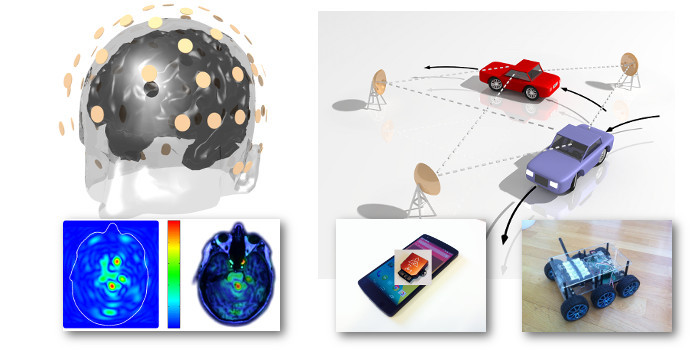Sensor informatics and medical technology
Research of the group focuses to sensor informatics, adaptive signal processing, and data fusion systems especially for medical applications. Other applications include smartphone sensor fusion, robotics, positioning systems, target tracking, and many other indirectly measured time-varying systems.
The term sensor informatics refers to methodology, which aims at deriving high-level information from single or multiple sensor measurements streams using advanced computational methods. The procedure of using multiple sensor data streams jointly is also called data fusion. For the computations, sensor informatics uses adaptive signal processing methods, machine learning, and statistical methods together with mathematical models of the physical phenomena. The used methods include Kalman filters, particle filters, Markov chain Monte Carlo (MCMC), Bayesian analysis, kernel methods, and non-linear classifiers among others.
An important application of the methodology is in medical technology where the aim is to measure the human health and body function using different kinds of biosensors. These biosensors include brain-imaging systems such as MEG, EEG, and fMRI; but also heart sensors (e.g., ECG), muscle activity sensors (e.g., EMG), and body movement sensors (e.g., accelerometers, microphones, or radar). Our group has developed many advanced methods for biosensor signal processing. In addition to medical applications, this kind of technology can be used, for example, in game controllers, security applications, remote surveillance, and in many other applications still to be invented.
The popularity of smartphones has created a recent demand for sophisticated data fusion and advanced signal processing methods, as they provide a wide range of motion and environmental sensors together with the computational power to run the methods in real time. Our group has developed methods, for example, for real-time tracking of orientation and location of a smartphone using the internal acceleration sensors, gyroscopes, and magnetometers; and for radio-positioning using measurements of the radio signals via RFID, WiFi, Bluetooth, 4G, or GPS. The sensors and the computational power of smartphones also enable a wide range of other uses, for example, in health care, gaming, and virtual reality systems among others.
Another important application area of sensor informatics and data fusion is in robotics. A basic need of a robot is to know where it is and how it is oriented with respect to its environment. Technically, this is the same problem that arises in the context of smartphones (see above). The planning of the motion of a robot also requires automatic determination of what kind of environment the robot is in, that is, determination of the map of its surroundings. This simultaneous localization and mapping (SLAM) problem also requires the use of advanced sensor informatics methods. Our group has developed methods also for this purpose. Similar methodology is also nowadays used, for example, in autonomous cars, airplanes, spacecrafts, and only the future will show what other applications will emerge.
The theoretical research of the group includes development of algorithms for highly non-linear and non-Gaussian systems. The mathematically most demanding research includes convergence analysis of particle filters and stability analysis of non-linear Kalman filters. The mathematical tools used here are measure theory, functional analysis, Lyapunov stability theory, and stochastic calculus.
The group is led by Professor Simo Särkkä
Current group members:
* Prof. Simo Särkkä (group leader)
* Dr. Roland Hostettler (research fellow, Aalto University)
* Dr. Ali Bahrami Rad (post-doc, Aalto University)
* Dr. Matti Raitoharju (part-time post-doc)
* Zenith Purisha (visiting PhD Student, Aalto University)
* Juha Sarmavuori (PhD Student, Nokia Ltd.)
* Toni Karvonen (PhD Student, EEA/ELEC, Aalto University)
* Filip Tronarp (PhD Student, EEA/ELEC, Aalto University)
* Zheng Zhao (PhD Student, EEA/ELEC, Aalto University)
* Rui Gao (PhD Student, EEA/ELEC, Aalto University)


